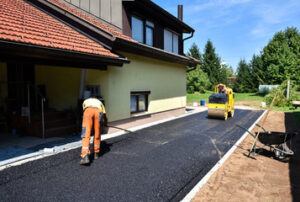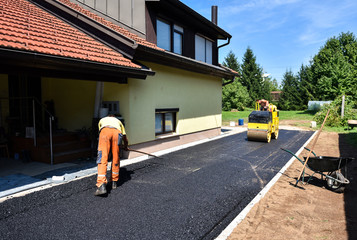Driveway Repair Charles Town WV can involve filling cracks, repairing potholes, and even rebuilding sunken sections of your driveway. Concrete driveways can be repaired using a concrete patching kit. 
First, clean the area where you want to make the repairs. This helps ensure that the repair material adheres appropriately. It also helps prevent weeds from growing in the damaged areas.
Unless your driveway is brand new, it will likely develop cracks. These are a natural part of the aging process, but you can take steps to minimize their appearance and slow their progress. The type of crack will determine how you address it.
Hairline cracks (up to 1/8 ” wide) appear as fine lines right on the surface of your driveway. These small cracks are cosmetic and mainly affect how your driveway looks; they don’t indicate structural problems. Filling these cracks with an elastomeric concrete filler will keep water out and preserve the surface of your driveway.
If the cracks are wider, they’re a sign that your driveway is under stress. This may be because of a bad pour or due to soil movement below the concrete. It might also be due to excessive vehicle weight or an old asphalt overlay that’s worn out.
The good news is, these cracks are relatively easy to repair. You can use a liquid crack filler that you can buy at most home improvement centers to fill these smaller fissures. This crack filler dries to a light gray that blends well with most driveway surfaces.
For larger cracks, you’ll need to use a masonry crack filler that comes in tubs at hardware stores. This material will hold up better to the elements and is more flexible than a liquid crack filler. You’ll need to widen these larger cracks with an angle grinder fitted with a diamond wheel to get the best results, but once you do this, it will provide a long-lasting fix for your driveway.
Large cracks in your driveway can be signs of a bigger problem that requires the help of a professional. If the cracks are more than 1/4 ” wide, you’ll need to put a foam backer rod into the crack before you fill it. This will prevent the sealant from pulling away from the old concrete as it expands and contracts with temperature changes.
When a large slab of concrete is poured, contractors form or cut control joints every eight to 10 feet. These help limit shrinkage cracks during curing and future slab movement. When these control joints separate, they can fill with dirt and debris, and vegetation might start growing. Filling these separated control joints with a high-strength polyurethane concrete crack filler will reduce their appearance and make the rest of your driveway look like it’s one continuous slab.
Potholes
A pothole is a hole in the surface of your driveway that can damage your car and be quite difficult to drive through. They are a result of weakened asphalt and often occur in sections that have been previously patched but never fully fixed. It is very important to fix potholes as soon as they appear as this prevents further damage and tripping hazards for anyone walking on your driveway.
The first thing to do is thoroughly clean the area that needs to be repaired. This can be done with a broom or blower to remove any dirt, gravel, leaves and any other debris that may have fallen into the pothole. It is also important to use a degreaser or cleaner to eliminate any oils and grime that are trapped within the pothole. Once the pothole is cleared it is essential to allow it to completely dry out before attempting to repair it again.
For gravel driveways or private footpaths you will need a cold patch product with an aggregate of 3-6mm. Make sure that the product you purchase is HAPAS (Highways Authority) approved as this will ensure it meets all of the stringent quality and testing measures. It is also a good idea to add some asphalt millings rejuvenator as this will help the new cold patch adhere and bond to the existing asphalt. Finally, a petrol plate compactor (we recommend the Hyundai pc300) is essential to ensure that the pothole is thoroughly compacted and no voids are left behind.
Dirt and gravel driveways tend to have less form than concrete, asphalt or brick driveways but dips, bumps and potholes can still occur. If a pothole is left unattended it will damage your car and eventually cause a section of the driveway to break away from the rest. To prevent this, potholes in dirt or gravel driveways should be filled as soon as they are noticed.
The best way to repair a pothole in a dirt or gravel driveway is to excavate the area and dig out about twice as large as the pothole itself. Then, using non-descript gravel, Class 3 crushed rock or recycled concrete fill the pothole in layers and compact it afterwards. This will prevent water from getting trapped in the hole and causing further damage to the surrounding base layer.
Sunken Sections
Concrete and asphalt driveways have a lifespan and, over time, they can begin to fail. A sunken driveway can detract from curb appeal and create safety hazards. It may also lead to structural damage to your home or business, including foundation issues and water leaks. If you notice your driveway is starting to sink, it is important to take action before the problem gets worse.
Sinking concrete in a driveway is usually due to a void beneath the surface. This void can be caused by soil erosion, shifting soil, a damaged foundation, or a variety of other factors.
The first thing you need to do is clear away any debris from the area with a brush, leaf blower, or garden hose. This will give you a good look at the damage and ensure that the patching material can adhere properly. Next, you need to make sure the damaged area is clean and dry. You can do this with a pressure washer or by using a garden hose or stiff broom.
Another option is to fill the sunken section with a sand and cement mixture. This process is known as mudjacking and will raise the area, but it is only a temporary solution. It will not address any of the root cause of the sinking, such as drainage or soil problems, so the issue is likely to return.
If your driveway has extensive areas of sinking, you may want to consider replacing it completely. This is the most expensive option and will typically be three to four times as costly as mudjacking or foam injection. However, if the existing concrete is still in good shape it could be the best choice.
Uneven driveways can cause problems with your vehicle, ranging from scraping and damage to bottoming out. Uneven driveways can also cause your vehicle’s wheels to become misaligned, which will result in handling issues and decreased fuel efficiency. In some cases, you may even need to replace your tires because they will wear out more quickly than they should. These problems can be avoided by keeping up with regular maintenance and taking steps to prevent erosion and other common causes of a sinking driveway.
Rebuilding
Occasionally, large cracks, a sunken section or other issues may necessitate tearing out the old driveway and replacing it. This is especially true if the cracks are interconnected and cover a large portion of the driveway, or if the concrete has become discolored and unattractive. However, even in these cases, it is possible to repair the damage to make the driveway usable again while keeping it affordable.
The first step is to determine the cause of the problem. If the cracks were caused by improper subgrade preparation, wrong concrete mix or shrinkage during curing, a replacement of the slab is necessary. However, if the cracks are due to weather-related conditions like freeze-thaw cycles or the use of deicing chemicals, these can be repaired with concrete patching.
Once the cracks are filled, the surface of the concrete is leveled and tamped down with a power tamper. This is also a good time to spray the entire driveway with a nonselective herbicide to kill any weeds that have grown up through the cracks and prevented the filler from bonding properly. Finally, a final layer of asphalt is added to the top of the driveway.
If the sunken sections of your driveway aren’t causing any structural problems, they can be raised back up to their original position by using a technique called “slabjacking.” This involves drilling small holes in the sunken area and pumping a material underneath it that raises it up. This method is much faster and less expensive than removing and replacing the sunken slab.
For larger areas of damaged concrete, it is sometimes cheaper to remove the damaged surface and replace it entirely. This is a good option if the driveway is old, has large cracks and fissures or has become discolored and tamped down with weeds. It is possible to resurface the concrete with an asphalt overlay, which gives it a new look and will keep it affordable. However, if the concrete is not sound, it is better to tear out and replace it.

